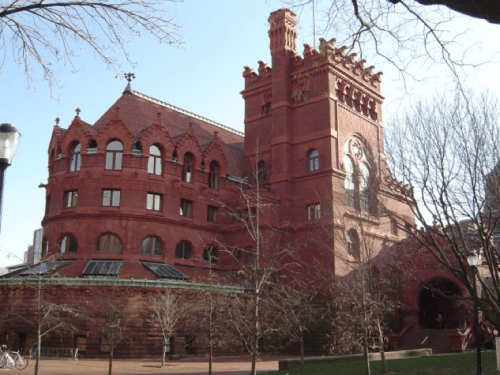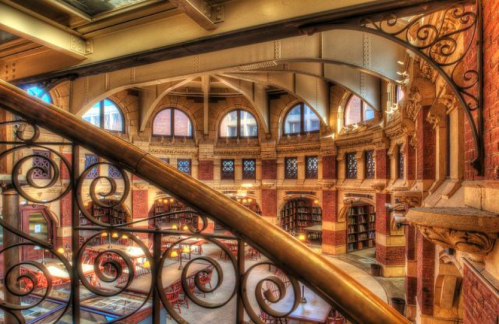By: Jorge Penado, C’19
International Relations Major
Work-Study Student, Sweeten Alumni House

Source: National Register of Historic Places
Gargoyles, Shakespearean-inspired writing on windows and a German-English architectural feud on Penn’s campus? The history of the famous Fisher Fine Arts Library holds a complicated yet interesting past that many of its students and alumni may not be aware of. While nowadays the library is regarded as one of Penn’s most unique buildings, on par with College Hall and The Quad, it wasn’t always accepted as that. Soon after its completion in the late 19th century, a transition in leadership in the university led to a complete re-evaluation of the architectural legacy of Penn. This shift would challenge the very existence of the building until it grew to be appreciated as a staple of campus a generation later.
Frank Furness (1839-1912), the Victorian architect of the library and native Philadelphian, entered the world of architecture early on in his life in 1857. After returning from serving in the Union in the Civil War, he eventually found himself back in Philadelphia where he began his own career through various architectural partnerships. After working on other famous projects like the Pennsylvania Academy of Fine Arts, his company was eventually hired to construct Penn’s first university library in 1888. Furness would invoke various unique designs in the construction of the library such as the interconnected nature of the five stories through the tower’s staircase or inscriptions on the windows chosen by Furness’s brother, Horace Howard Furness, a Shakespearean scholar and Penn faculty. The library was completed and dedicated in 1991 but would soon face various obstacles to its continued existence.

Source: University of Pennsylvania Fine Arts Library Image Collection
Furness’s architectural style, which aligns closely with a German-model focused on graduate studies and technical scientific research with expansive room instead of the English-model focused on undergraduate education and socialization, would lead to some controversy. Furness’s greatest supporter, then-Provost William Pepper Jr., was in the German-model camp and actively supported Furness and similar projects like the School of Engineering and the Wharton School. However, once Provost Pepper retired, his successor, Provost Charles Custis Harrison, was much less supportive of the German-model and preferred the English-model as seen with his construction of The Quad. Provost Harrison would challenge the design of the library by even questioning the “historically-incorrect gargoyles,” on the exterior of the library. This clash of visions would lead to Provost Harrison cancelling Furness’s future architectural projects and would even label the library an embarrassment to Penn, seriously considering cloaking the building in a different style.
Lucky for us, the library was never cloaked and was actually listed on the National Register of Historic Places in 1972 and declared a National Historic Landmark in 1985. The building would be restored and expanded from 1986 to 1991 with the primary benefactors being Anne and Jerome Fisher to whom the building is now dedicated. Through a turbulent history, the Fisher Fine Arts Library fortunately still stands on the east side of College Green with its red sandstone and Venetian Gothic architecture being a definite landmark of Penn’s campus.

Source: University of Pennsylvania Flickr Account



